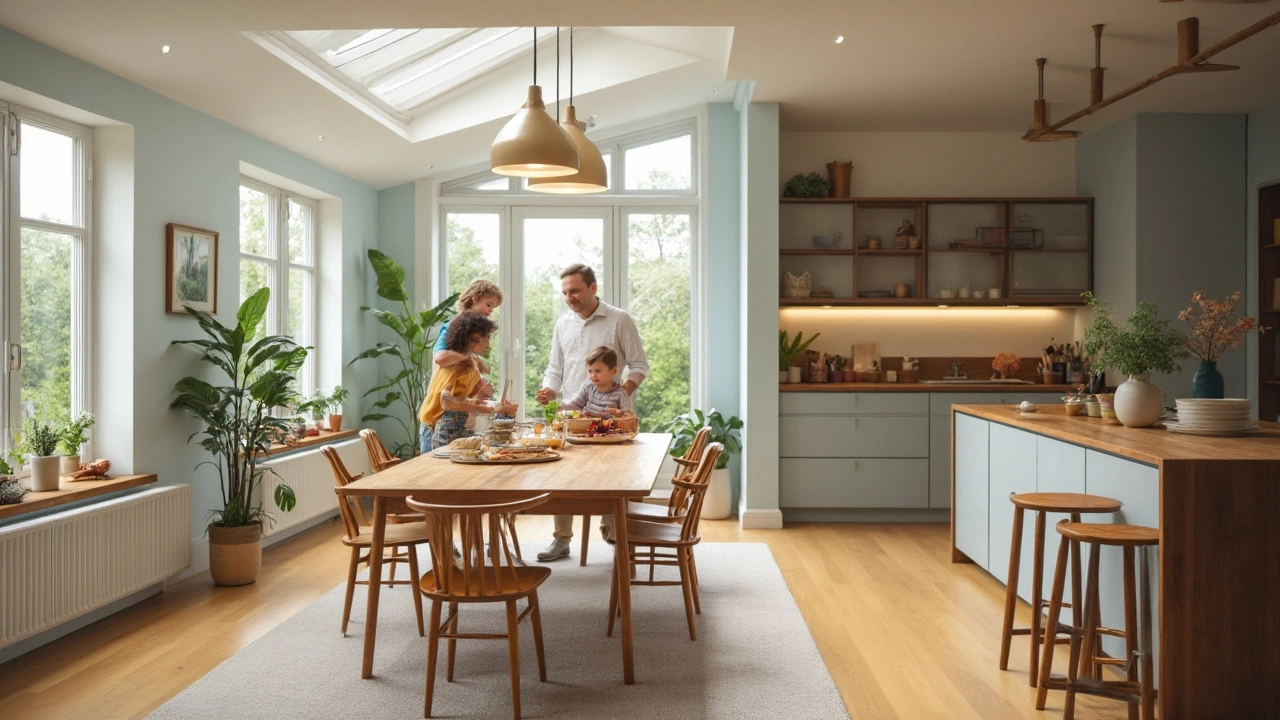If you're looking at your dining room and wondering if it's just collecting dust, you're not alone. Kitchens have turned into hangouts, kids do homework everywhere, and with open floor plans, traditional dining rooms can feel a bit outdated. Why keep a room that only gets used on holidays?
The way we live is changing fast. People eat dinner at kitchen islands, sprawl out on the couch, and grab snacks in front of the TV. Even big family meals are often moved to the kitchen table, if you have one. A massive formal table and chairs for eight? For most, that's now a spot for laundry piles, not dinner parties.
- The Changing Role of the Dining Room
- Open Concepts and Multipurpose Spaces
- When a Dining Room Makes Sense
- Making the Most of Your Dining Area
The Changing Role of the Dining Room
Back in the day, the dining room was the heart of family gatherings and Sunday roasts. These days, fewer people use it regularly. It's not just a trend—it's a full-blown shift. Surveys from the National Association of Home Builders show that less than half of new homes in the U.S. have a separate dining room. What changed? Modern families are busier and more casual about meals. People eat when it's convenient, often in smaller groups or even alone, which makes dedicating an entire room just for dining seem a bit much.
The rise of open layouts is a big reason for the switch. In the 1980s and 90s, formal dining rooms were everywhere. But over the last twenty years, open kitchens with islands and big tables right next to the living space became more popular. The goal is obvious: keep everything bright, breezy, and social. Now, eating and hanging out often happen in the same spot. Less formality, more connection.
But that's not the only reason dining rooms are fading. With more people working from home, that unused dining area often becomes an office, craft room, or play zone. Some folks even use it as a home gym. It's just practical—why reserve a chunk of your home for something that happens a few times a year?
Still, some traditions stick. Holiday meals or birthday dinners can feel special in a set-aside room. So, the big question is whether a dining room fits your actual lifestyle or just holds onto old habits.
Open Concepts and Multipurpose Spaces
Open concept homes have taken over. If you walk into a house built after 2000, chances are the kitchen, living, and dining spaces all blend together. According to a National Association of Home Builders study from 2023, nearly 90% of new homes feature some type of open main floor plan. That means walls are coming down and rooms have to pull double duty.
Instead of a closed-off dining room, most people zone their open space with rugs, lighting, or different furniture setups. Need to host a dinner? Rearrange your table and chairs. Kids need to do homework? Slide computers onto the same table. Sometimes your dining zone turns into a game area at night and a work meeting spot during the day. Few people reserve a big space just for eating anymore.
Making a space multipurpose can actually help you use it more often. Here's how families squeeze every bit of value out of their dining room furniture:
- Choose an extendable table for small daily meals and big group dinners.
- Use stackable or folding chairs you can stash away when not needed.
- Pick storage benches for seating so you have somewhere to hide toys or blankets.
- Set up smart lighting with dimmers—brighter for work, softer for dinner.
- Keep a rolling cart loaded with supplies for crafts, homework, or bar service.
If you’re wondering about how this trend is showing up in real numbers, this quick table shows what people say they use their open space for, based on a 2024 home survey:
| Activity | % of Households Using Dining Zone |
|---|---|
| Eating Meals | 77% |
| Work/Study | 48% |
| Socializing/Entertaining | 60% |
| Crafts/Hobbies | 36% |
| Games | 28% |
It’s pretty clear: people want flexible, open rooms that can do more than one thing. The old rule of keeping dining areas formal just doesn’t fit how most of us live right now.

When a Dining Room Makes Sense
Even with all the talk about open plans and eating in the kitchen, having a dedicated dining room isn’t just for traditionalists. For a lot of families, it really does pay off. If you like to host big holiday meals, love the idea of dinner parties, or need a spot for Sunday roasts, a separate dining space gives everyone more elbow room. You can set the table and actually enjoy the meal instead of fighting for space at the kitchen counter.
Formal dining rooms work especially well for people with big families, kids’ birthday parties, or when you want to keep food mess away from your TV and gaming zones. Plus, if you work from home and don’t have a proper office, a dining room is easy to flip into a meeting or homework area—often without mixing it up with the chaos of your everyday living space.
| Who Benefits Most from a Dining Room? | Why It Helps |
|---|---|
| Large families/hosts | More space for meals and gatherings |
| Frequent entertainers | Impress guests with a comfortable setup |
| Remote workers | Easy to use as a workspace |
| DIYers/crafters | A dedicated spot for big projects |
If you want versatility, a dining room can also double as a games spot for board night or somewhere to spread out jigsaw puzzles. Some folks even use it as a homework station or space to tackle big art projects. So, if any of this sounds like it would make your life easier, hanging on to or revamping your dining room totally makes sense.
Making the Most of Your Dining Area
Your dining room doesn’t have to be stuck in the past. You can actually use it in a bunch of different ways without knocking down walls or buying fancy new furniture. The trick is to make it fit how you really live, not how furniture catalogs say you’re "supposed" to use it.
First, think about what you actually need from the space. If you host game nights or need a spot for kids to do homework, try a big, sturdy table that does double duty. Storage benches add hidden space for board games or school stuff. You can even bring in a small shelving unit or bar cart—way easier than big china cabinets and way more useful.
Lighting can totally change the feel. Swapping out a formal chandelier for a set of adjustable pendant lights makes everything more relaxed and less "company-only." You’ll notice people linger longer if the room feels cozy instead of stiff.
Don’t be afraid to mix things up with seating. Benches on one side and chairs on the other? Totally works and saves space. And if you’re tight on square footage, go for a round table—it’s easier to squeeze in more people, especially during special occasions.
If you’re curious how other families actually use their dining rooms now, check out this data from a 2024 survey by the National Association of Home Builders:
| Primary Use | Percentage of Households |
|---|---|
| Eating meals as a family | 38% |
| Doing work or homework | 27% |
| Hobbies/crafts/games | 19% |
| Entertaining guests | 10% |
| Storage/laundry overflow | 6% |
Here are a few practical ways to get more out of whatever space you have:
- Try multi-use furniture like extendable tables, storage benches, or stackable chairs.
- Add wall hooks or shelves to handle backpacks, bags, or art supplies.
- Use washable rugs and easy-to-clean chairs if your dining space doubles as a homework or project zone.
- Think about rolling carts you can pull out when you need them and tuck away later.
- If you don’t use a formal dining set, replace it with a cozy breakfast nook or reading area. No law says you need a giant table.
The real win: Make your dining room pull its weight for your family and your life. If it works better as a home office during the day or a craft spot most weekends, go for it.


